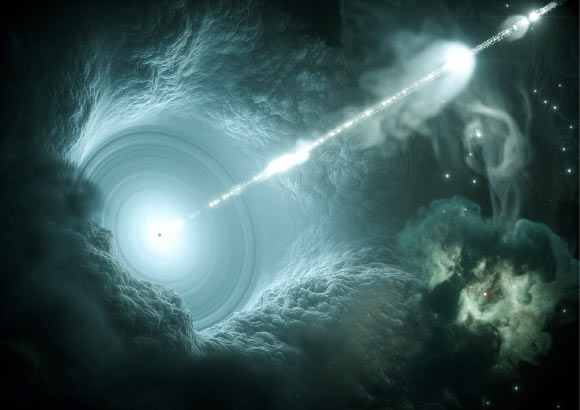Do Gamma-Ray Jets Really Achieve Superluminal Speeds? | Astronomy – Sci-News.com
High-speed particle jets from gamma-ray bursts may exceed the speed of light in surrounding gas clouds, but do so without violating Einstein’s theory of relativity, says a team of astrophysicists from the Michigan Technological University and the College of Charleston.

An artist’s impression of a particle jet emanating from a black hole at the center of a blazar. Image credit: DESY / Science Communication Lab.
Gamma-ray bursts are the most luminous explosions in the Universe.
Most occur when some types of massive stars run out of fuel and collapse to create new black holes. Others happen when two neutron stars, superdense remnants of stellar explosions, merge.
Both kinds of cataclysmic events create jets of particles that move near the speed of light.
Michigan Technological University’s Professor Robert Nemiroff and Professor Jon Hakkila from the College of Charleston propose that these jets could reach superluminal speeds and create the time-reversibility seen in light curves of the gamma-ray bursts.
These proposed jets, however, do not violate the Einstein’s relativity because they only move faster than light does through the jet medium, not faster than light through vacuum.
“A good way to visualize this superluminal motion is to imagine someone on one side of a pond skipping a stone across the water in your direction,” Professor Hakkila said.
“The frequently-hopping stone moves through the air between hops faster than the waves it generates move through water.”
“You would see waves created by each skip of the approaching stone in reverse order, with waves from the most recent skip arriving first and those from the initial skip arriving last.”
“This superluminal blast explanation retains many characteristics of accepted gamma-ray burst jet models.”
“However, our scenario involves Cherenkov radiation, a type of light created by superluminal motion that was not previously thought to be important in generating the light curves of gamma-ray bursts,” Professor Nemiroff added.
“Standard gamma-ray burst models have neglected time-reversible light curve properties,” Professor Hakkila said.
“Superluminal jet motion accounts for these properties while retaining a great many standard model features.”
The team’s paper was published in the Astrophysical Journal.
_____
Jon Hakkila & Robert Nemiroff. 2019. Time-reversed Gamma-Ray Burst Light-curve Characteristics as Transitions between Subluminal and Superluminal Motion. ApJ 883, 70; doi: 10.3847/1538-4357/ab3bdf






